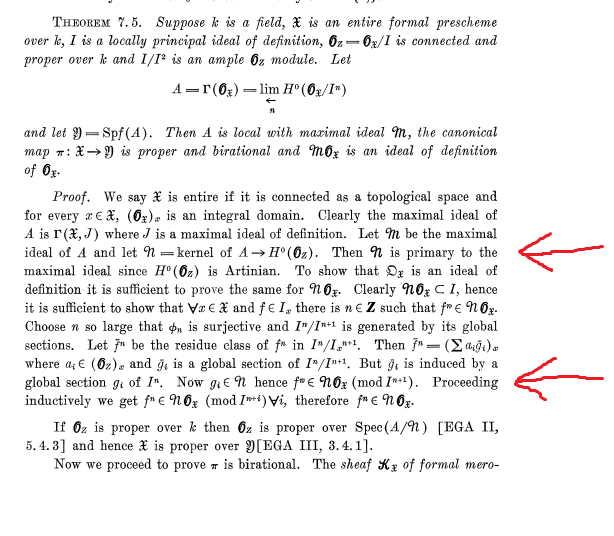I have few questions about the proof of Thm 7.5 from P. Wagreich's paper "Elliptic Singularities of Surfaces" (page 452):
Denote by $\mathcal{N}$ the kernel of $A \to H^0(O_Z)$ (sorry, I haven't found the latex command for such winged "N" from the excerpt :(
- QUESTION:The author says that $\mathcal{N}$ is primary to the maximal ideal $\mathcal{M}$ of $A$ "since $H^0(O_Z)$ is Artin ring".
I don't understand this argument. $\mathcal{N}$ primary to $\mathcal{M}$ means by definition that $\sqrt{\mathcal{N}}=\mathcal{M}$. Every kernel is prime ideal and so this would imply $\mathcal{N}= \mathcal{M}$. This seems absurd, following futher steps in the proof. Or do I miss something?
next problem:
The proof shows that for a $f \in I_x$ the power $f^n \in \mathcal{N}O_{\mathcal{X}} (mod \text{ } I^{n+1})$.
Rmk: It was implicitely used Lemma 7.4 form the paper which implies that for $n$ big enough $H^1(I^{n+1})=0$ so $H^0(I^n) \to H^0(I^n/I^{n+1})$ is indeed surjective.
- QUESTION:I don't know how to perform the induction step to show that for $f \in I_x$ we have $f^n \in \mathcal{N}O_{\mathcal{X}} (mod \text{ } I^{n+i+1})$ under assumption that $f^n \in \mathcal{N}O_{\mathcal{X}} (mod \text{ } I^{n+i})$ already holds.

